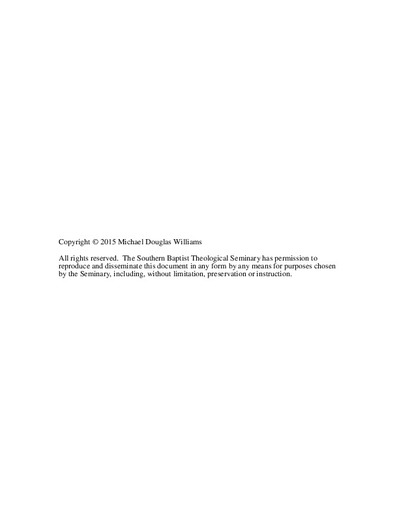| dc.description.abstract | A TEXTUALLY-ARRANGED, GENRE-SENSITIVE,
RHETORICALLY-INFORMED
HOMILETICAL APPROACH
Michael Douglas Williams, Ph.D.
The Southern Baptist Theological Seminary, 2015
Chair: Dr. Robert A. Vogel
Chapter 1 introduces the subject of this dissertation, which deals with the relationship between a biblical text’s substance and structure to that of a sermon’s substance and structure from that text. After stating the thesis of this dissertation—that expository preaching considers the arrangement of the text, is sensitive to the genre of the text and aware of the rhetorical impact of the text in order to faithfully and effectively communicate the Word of God—the introduction outlines the approach that this work follows.
Chapter 2 begins by exploring the origin of inspiration as that of both divine and human. B. B. Warfield refers to this divine-human cooperation as the Spirit of God working confluently through the work of men. The chapter emphasizes how this divine-human cooperation came through a verbal-plenary view of inspiration. If inspiration extends to not only the writer’s thoughts but also his words, then the literary forms in the Bible are equally inspired. Therefore, the extent of the doctrine of inspiration to that of
genre is of great importance to this dissertation.
Chapter 3 describes the importance of hermeneutics and genre. I state my
presupposition for authorial intent and single meaning of the text. Upon this authorial intent and single meaning foundation, I discuss principles for hermeneutics in general. More specifically, I establish the crucial role of literary sensitivity in the hermeneutical task. Essential in understanding the genre is an awareness of surface and notional structures, as well as what the author is doing (speech act) through that particular genre (structure). In short, to ignore literary form, as D. A. Carson insists, is to fall prey of two dangers: to insist that Scripture is saying what in fact it is not saying or to indeed miss what Scripture is actually saying. The chapter provides interpretative guidelines for genre sensitivity by exploring five primary genres found in the Bible.
Chapter 4 discusses the aim of rhetoric and, in particular, the significance of the canon of arrangement on a given discourse. After discussing the aim of rhetoric and homiletics as that of persuasion for maximum impact, this chapter focuses upon the canon of arrangement and, thus, the reality that structure argues. The chapter then offers similarities and differences of the canon of arrangement with that of expository homiletics.
Chapter 5 synthesizes a textually-arranged, genre-sensitive, rhetorical-informed homiletic. The chapter explores two areas of relevance for preaching: the need for head and heart and the need for textual sermonic structure. In particular, the first section deals with the primacy of preaching holistically. The second section addresses the necessary importance of textual sermonic structure around the consideration of biblical genre. The section offers sermonic examples from five genres, considering generic structures and rhetorical aim. The section concludes with a structural analysis of two sermons.
In conclusion, chapter 6 presents a restatement of the thesis and summary of
my arguments. The chapter urges expositors to faithfully and effectively preach the Bible by considering the structure of the text, being sensitive to its genre, and being aware of its rhetorical impact. | en_US |

